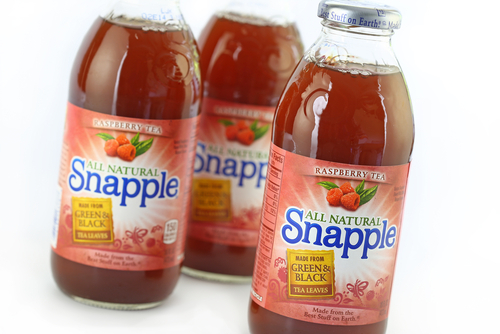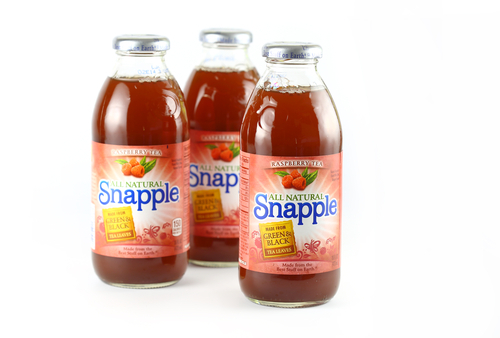Short answer
Snapple is bad for you. It may contain very few ingredients, but they are not healthy. When consumed regularly, Snapple can lead to a host of negative effects.
Recommended Alternative
Long answer
Snapple, made by Dr. Pepper, is a flavored fruit and tea drink that many enjoy instead of soda. However, is it any better for you? Has Dr. Pepper created a beverage that is really all-natural?
Snapple says that: “Our Real Tea Starts with the Finest Tea Leaves and is Made from Filtered Water, Sugar, Citric Acid, Tea, Natural Flavors”.
To have the “finest tea leaves” surely means that the tea in their drinks is pure and as beneficial for you as a regular cup of tea. The truth is that bottled teas contain almost no antioxidants. Antioxidants give tea a bitter taste and beverage companies that want to deliver a sweet and satisfying drink to their customers do not want that unpalatable taste lingering in their mouth, so they alter the flavor and water it down. Antioxidant levels also tend to decrease after being brewed and processed. This leaves the resulting tea that we drink even lower in antioxidants. By this time it’s not much of a tea drink anymore.
After water, the next ingredient is sugar, meaning that it’s the second most abundant ingredient in Snapple, apparently outperforming tea by a long shot. Per severing, Snapple contains 160 calories most of which come from the 39 grams of added sugar. That is a whopping 156% of our recommended daily value!
The average American consumes about 400 calories worth of sugar daily, or 25 teaspoons, more than double the amount in a Snapple. Sugar is not nutritional, it contains many calories, causes tooth decay, causes insulin resistance contributing to type 2 diabetes, causes metabolic disorders leading to inflammation and cancer, contains dopamine causing addiction and increases the risk of obesity.
Something to note is the Snapple does not specify what kind of sugar they use in their recipe. Unless clearly stating to be made from pure cane sugar, it is likely that they use GM (genetically modified) sugar beets.
Citric acid, the following ingredient in Snapple, may also be made from GM sugar beets and GM corn. Citric acid is a byproduct produced by the fermentation of glucose from Aspergillus niger mold. In concentrated amounts, it can irritate the stomach, damage stomach lining, and cause heartburn and tooth decay.
Snapple claims to be all-natural because it only contains natural flavorings. Again, we see another example of false advertising. Whether natural or artificial, flavors are added to make a product taste better, it’s not about the nutritional value. Both are chemically enhanced in a lab and can contain anywhere from 50 to 100 ingredients. The only difference between the two is that the origin of one comes from a natural source. For example, castoreum is commonly used for vanilla, raspberry and strawberry flavors. Castoreum comes from the castor sacs of a beaver’s anus. It’s natural, but not appetizing.
Possible short-term side effects
- spike in blood sugar levels
- sugar rush
- heartburn
- upset stomach
Possible long-term side effects
- tooth decay
- insulin resistance
- type 2 diabetes
- metabolic disorders
- inflammation causing cancer
- addiction
- obesity
- damage to stomach lining
Ingredients to be aware of
- sugar
- citric acid
- possible gmos
- "natural flavors"

Healthier alternatives
- home brewed tea
Our Wellness Pick (what is this?)
Honest Just Green Tea
- Zero added sugars
- Full of antioxidants
- Organic ingredients
- Conveniently bottled
- Hydration on-the-go
 Approved by
Approved by 















